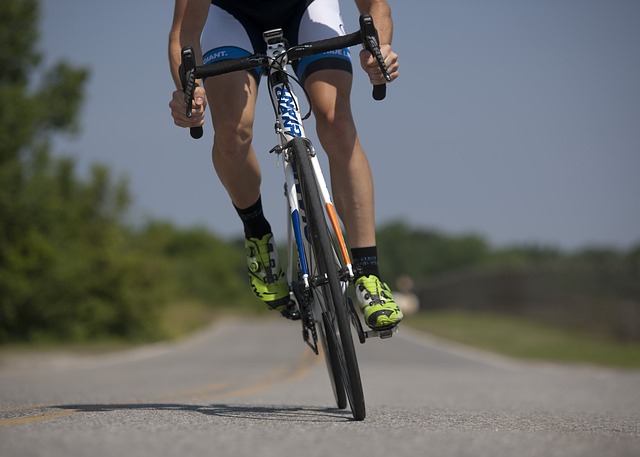Bolest kolen v cyklistice
Bolesti kolenních kloubů jsou v cyklistice poměrně častou záležitostí. Kolena při jízdě na kole sice nejsou tolik zatížena tělesnou hmotností a nárazy, jako například při běhu, ale i přesto zde vznikají poměrně velké silové momenty a dochází k pohybu v rozsahu zhruba 5 – 120 stupňů.
Místo bolesti pohybového aparátu většinou neodpovídá místu příčiny bolesti. A tak tomu je i u kolene. Na funkci tohoto nejsložitějšího kloubu těla je třeba se dívat v širších souvislostech. Funkce kolenního kloubu je přímo ovlivněná postavením a funkcí kloubů nohy, kyčelního kloubu, postavením pánve i páteře. Bolesti kolenního kloubu mohou mít příčinu v něm samotném, jako tomu je v případě úrazů (např. menisků, nebo vazů). Tato problematika ale není v cyklistice běžná, proto ji pomineme. Bolesti kolen mohou mít také příčinu ve vzdálených oblastech, nejčastěji jsou způsobené poruchou svalové koordinace.
Proč kolena bolí nejen cyklisty? Klíčem k pochopení problému je práce svalů v souhře.
Obecně nejčastější příčinou bolestí pohybového aparátu jsou tzv. funkční poruchy. Jedná se o poruchy svalové koordinace, tedy práce svalů ve vzájemné souhře. Při optimální svalové koordinaci jsou kloubní plochy v maximálním možném kontaktu a zatížení je tedy rozloženo na co největší plochu. Pokud jsou některé svaly, nebo části svalů v převaze a jiné v útlumu, mění se vzájemné postavení kloubních ploch a některé části jsou zatěžovány více, jiné méně. Takto dochází k předčasné degeneraci chrupavky kloubu. Svaly, nebo jejich části, které jsou ve zvýšeném napětí, jsou sami o sobě zdrojem bolesti. Mohou bolet i jejich úpony, za které svaly chronicky táhnou. Dalším zdrojem bolesti mohou být přetížené části kloubních ploch. K poruše svalové koordinace může dojít různými vlivy, může se tak stát například následkem úrazu, jednostranné nadměrné zátěže nebo se tato koordinace nevyvinula dobře už v raném dětství.
Kvalita svalové koordinace hraje významnou roli v zatížení kolenního kloubu i v cyklistice. Můžeme říci, že čím je horší kvalita svalové koordinace, tím dochází k většímu opotřebení. Zátěží a jejím stupňováním, při neideální koordinaci, se toto riziko násobí.
Provádíme fyzio konzultace pro cyklisty, přijeďte na svém kole, či si nechte zanalyzovat váš styl na wattbike. Zjistíme a upravíme odchylky, naučíme vás cvičení a kompenzaci.
Rozlišení bolestí kolenního kloubu
V cyklistice se může jednat o úponové bolesti, způsobené jak svalovou nerovnováhou, tak nadměrným zatížením, nebo obojím. Některé tyto obtíže mohou mít příčinu velmi vzdálenou od samotného místa bolesti.
Bolest na vnitřní straně pod kolenem
je způsobená zvýšeným napětím svalů, které se zde upínají. Tyto svaly jsou v hypertonu při poruchách kyčelního kloubu nebo blokádách kloubů páteře.
Bolest na horním nebo dolním pólu čéšky
je daná zvýšeným napětím především přímé hlavy čtyřhlavého svalu. K tomu může dojít jak v důsledku nadměrného zatížení, tak především poruchou svalové souhry ovlivňující postavení pánve a blokádami v bederní páteři. Pánev je v tomto případě v anteverzi, tedy naklopená dopředu. Toto postavení si sebou neseme zpravidla už od prvních měsíců života, kdy nedošlo k správnému zapojení břišních svalů.
Bolest na zevní straně pod kolenem
se vyskytuje při blokádě hlavičky lýtkové kosti v místě skloubení s kostí holenní. Tato blokáda vzniká při zvýšeném napětí dvouhlavého stehenního svalu. To je ale opět dáno postavením pánve, neoptimálním zapojením břišních svalů a blokádami v bederní páteři.
Bolest kolene zepředu.
Pravděpodobně nejrozšířenějším problémem v cyklistice je tzv. femoropatelární bolestivý syndrom, někdy též nazývaný jako chondromalacie pately. Čéška, neboli patela, má vlastně funkci kladky pro čtyřhlavý sval stehenní. Je vložena do úponu tohoto svalu a zefektivňuje jeho práci. Při kontrakci quadricepsu dochází ke stlačení čéšky do kloubu. Jízda na kole, především do kopce, ale například i chůze po schodech, vyžaduje poměrně silnou kontrakci quadricepsu. Vznikají zde tedy velké tlaky na čéšku a na chrupavku pod ní. Jak už bylo řečeno, pro rozložení zatížení kloubu je podstatná kvalita svalové koordinace. Stejně tak pro čéšku. Aby došlo k co největšímu rozložení síly na kloub, musí být čéška co nejlépe stabilizována. Pro ideálně stabilizovanou čéšku je potřebná vyvážená funkce zevní a vnitřní hlavy čtyřhlavého svalu stehenního. A právě tato souhra bývá často porušená. V tom případě je čéška tažena, případně i naklopena zevně. To je způsobeno funkčním útlumem vnitřní hlavy a převahou zevní hlavy, která přetáhne čéšku na svou stranu. Dochází tedy k nadměrnému zatížení zevní části kloubní plošky, jejím bolestem a postupným degenerativním změnám chrupavky této části kloubu.
Na poruše této souhry se podílí několik faktorů. Jsou to jednak faktory biomechanické, kdy dochází k zvětšení tzv. Q úhlu. Q úhel je úhel, který vytváří osa tahu quadricepsu s osou stehenní kosti. K zvětšení tohoto úhlu dochází při postavení kolene do X, které se pojí s naklopením pánve dopředu a oploštěním podélné klenby. Toto chybné postavení v koleni tedy vzniká jako následek špatné svalové souhry v oblasti pánve a trupu, nebo v oblasti nohy. Q úhel zvětšuje také široká pánev. V těchto případech patela cestuje zevně a toto postavení způsobuje, že zevní hlava quadricepsu je ve výhodnějším postavení než hlava vnitřní. Ženy, poněvadž mají širší pánev a častěji kolena do X, jsou více predisponované k těmto potížím.
Může ale také dojít k samotné poruše svalové koordinace, i přesto, že nemáte biomechanické dispozice. Vnitřní hlava quadricepsu je totiž extrémně zranitelná a má tendenci z funkce vypadnout. Může se tak stát například následkem úrazu (např. ruptura nebo jen natažení vazů, poškození menisků atd.) ale i jednostrannou zátěží a pohybovou chudostí.
Jak si s bolestí kolene pomoci?
Jak vidíte, bolest kolene je často komplexní problém pohybového aparátu. Pro odstranění příčiny potíží je nutná cílená fyzioterapie, tedy aktivace správné svalové souhry nejen v oblasti kolene, ale i nohy, kyčle a pánve. Cvičení na bolest kolene se tedy rozhodně nebude točit okolo kolene samotného.
Co můžete dělat sami? Samozřejmostí je protahování svalů, čímž ulehčíte jejím úponům. Je třeba protahovat všechny svalové skupiny dolních končetin, především ale přímou hlavu quadricepsu. Vhodné je také cyklistiku kombinovat s jiným sportem, protože pohybovou různorodostí zlepšujete vnímání těla a svalovou koordinaci.
Při jízdě na kole je nutné vytvořit vhodné biomechanické podmínky pro kolenní kloub. Jedná se především o nastavení sedla, co se týče vodorovného posunu, vůči pedálům. Když máte pedály ve vodorovné poloze a nohu zacvaknutou do pedálu, kolmice spuštěná od kolene by měla protínat střed osy pedálu. Pokud bude koleno před středem pedálu, bude toto postavení jednak biomechanicky nevýhodné a hlavně bude docházet k nadměrným tlakům na patelu.
Dále se jedná i o techniku jízdy na kole, především postavení v kyčli. Pokud směřují kolena dovnitř, znamená to, že v kyčlích jsou vnitřní rotace. Toto postavení je jednak nevýhodné pro kyčle a také je při něm znevýhodněná ve funkci vnitřní hlava quadricepsu a více se bude zapojovat ta zevní. Dále dojde k přetížení vnitřních rotátorů v kyčli, budou tedy ve zvýšeném napětí svaly vnitřní strany stehen, tzv. krátké adduktory. Ideální pro kyčelní kloub je, pokud s rostoucí flexí narůstá i zevní rotace. Čím víc tedy pokrčíme nohu v kyčli, tím víc by mělo jít koleno do strany. Tímto souhybem zajistíme maximální kontakt kloubních ploch. Pro jízdu na kole z toho vyplývá, že ve chvíli, kdy jde koleno nahoru, bychom ho měli vytočit i mírně zevně. Závodní jezdec tento souhyb pravděpodobně nepoužije, kladl by tak větší odpor vzduchu, ale ostatním to vřele doporučuji i za cenu mírného zpomalení. Přece jen klouby máme jenom jedny!

